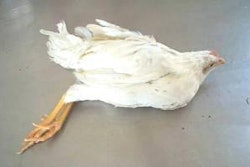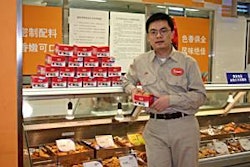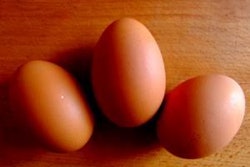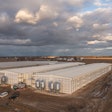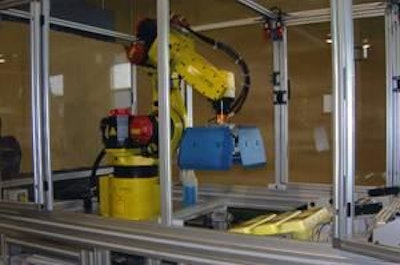
Smart Motion Robotics (SMR) of Sycamore, Ill., hosted a two-day event to demonstrate its range of robotic technology especially developed for shell-egg plants. Established in 2000 by Scott Gilmore, the company has expanded to develop custom robotic applications for the food and pharmaceutical industries for over a decade.
The robots used by SMR are manufactured by FANUC – the leading developer and manufacturer based in Japan. This company has supplied over 200,000 units worldwide, representing 50% of the global market. SMR is authorized by FANUC as a “Designated Authorized Integrator” to develop and install robotic technology in egg plants. All robot installations are backed by the supplier, which operates 10 service centers in the U.S. and undertakes to respond to e-mail and telephone technical service requests within 20 minutes on a 365/7 schedule.
Advantages of robotics
In introducing robotic technology to U.S. egg packers, David Voell, senior vice president, outlined the differences between robots and simple mechanization.
- Robots have diverse capabilities, strong capacity and speed using servo motors, with some units capable of handling payloads of up to 1 ton at rates of more than 12 cycles per minute.
- Robots have extreme flexibility and adaptability, as they are programmable and capable of multi-tasking. This is important with handling a variety of packs, cases and pallet configurations.
- Robots are extremely reliable and generally operate for over 70,000 hours without requiring major overhaul. Routine maintenance is minimal since the units are built to high specifications and to withstand harsh environments.
- Robots can be programmed to perform a variety of functions within the reach of the arm. Attaching specialized “end-of-arm tools” it is possible to perform a variety of tasks as new functions are introduced into the plant.
- Robots can interface with plant networks and control systems and are compatible with bar coding required for traceability, machine vision for quality control and inventory management in the context of U.S. packing plants
One existing user at the open house commented that “once imported into the U.S. and incorporated into a robotic system the unit continues working, complies with immigration requirements, works tirelessly without complaint, does not take tea or lunch breaks and is always there at plant start-up and does not object to working overtime.”
SMR product range for packing plants
The SMR range of robotics for packing plants was originally developed in response to the need for speed, consistent quality and cost. The current range comprise the SmartPACKER™ a robotic egg-case packer, the SmartTOPPER™ which places covers over the top layer of eggs in cartons and the SmartSTACKER™ which is a robotic egg case palletizer.
SMR Smar tPacker ™
The robotic SmartPACKER™ is available in two models depending on packing amenities, desired speed and floor space operates at up to 70 cases per hour taking cartons from two adjacent packers. The SmartPacker™ will handle pulp, foam, and PET tri-fold cartons and will transfer to 15, 24 and 30, 24 dozen cardboard and plastic cases as used in the U.S.
The Smart PACKER™ cannot handle wire baskets due to their unevenness associated with transport damage. SmartPACKERS™ have been installed on Diamond 8300, 8400, Innova and Moba Selecta and Omnia packers. The units incorporate open carton rejection and can be supplied with machine vision to detect carton damage or other defects.
SMR SmartTOPPER™
The SmartTOPPER™ is capable of placing tops on flats which will be shrink-wrapped or on the top tier of eggs on flats in a case. The unit can incorporate machine vision and barcode recognition to confirm correspondence between the SKU imprint on cartons and cases.
SMR SmartSTACKER ™
The SmartSTACKER™ can palletize up to four different products simultaneously and can operate in an area of approximately 1,000 ft.2, excluding the conveyors and bar code sorting station. SmartSTACKERS™ can be supplied with pallet and slip-sheet dispensers and can be programmed to stack cases in specific patterns for secure transport, especially for DSD applications. As with all SMR robotics, the SmartStacker™ conforms to RAI safety standards. The unit is equipped with a vacuum pump which activates the suction grippers on the end-of-arm tool. This innovation developed by SMR is more efficient and reliable than venturi vacuum lifters. In operation the SMR SmartSTACKER™ is usually supplied with packed cases and pallets using mechanized conveyors which are configured to match the speed of operation.
Installations
Due to the diversity in plant layouts, types of cartons, cases and product flow, Scott C. Gilmore and his design and applications team configure each installation for optimal efficiency. Individual modules or a complete line are assembled and tested using the client’s packing material to ensure correct operation before disassembly, crating and shipping. This facilitates assembly and commissioning in the plant, reducing down time and build-up of product awaiting packing during a retrofit. This is an important consideration with in-line plants that operate on a single or double shift on a 365-day basis. The visitors to the SMR open house viewed an installation undergoing pre-shipment testing which included mechanical, electrical and electronic procedures prior to installation in a new plant in Latin America.
Voell also provided information on capital cost and operating characteristics for a complete installation. A number of the participants indicated production costs and crew requirements for their plants operating with and without robotics. This data was used to project operating costs and savings.
Financial projections
Table 1 indicates the production parameters for an in-line plant processing the output of 1.5 million hens. The manager of a plant in Michigan indicated that they had achieved a 2% reduction in breakage following installation of a SmartPACKER™ attributed to more gentle transfer of packs to cases. The improvement in quality was evident in the sharp drop in store returns associated with shell cracks in eggs at the ends of the pack and the occurrence of leakers. The calculation used in this projection incorporated a 1% improvement in product yield.
Table 2 details the capital and operating costs of a complete SMR robotic installation. This would include five robotic packers to serve 10 lanes with manual packing ofthe remaining production representing 20% of throughput. The plant would require one robotic SmartTOPPER™ and a single robotic SmartSTACKER™. Required computers, conveyors, shipping and installation would be included in the projected capital cost of $1,350,000. It is assumed that the capital cost would be funded one-third in the form of equity invested by the plant and two-thirds would be covered by a loan at 7%.
Operating costs were assigned to fixed and variable components. Interest amounted to $63,000 per year and equipment was depreciated at 10% p.a. amounting to $135,000 which is not an actual cash out-flow. Power requirement listed under variable components is relatively low given the efficiency of servo motors and a 480 volt three-phase supply. Maintenance was assumed to be 1.5% of value. The total annual operating cost was projected at $225,000 for the demonstration installation for a 500 c.p.h. plant which was reviewed at the open house.
Table 3 calculates the benefits attributable to robotic technology arising from the saving in labor. The crew that will be used in a conventional plant would generate an annual cost of $525,950. Installing robotics would reduce the number of workers involved in packing, topping and stacking from 11 to 3 for a total cost of $142,350 per year. The annual difference of $379,600 can be applied to reducing the loan or in the event of outright purchase, providing a payback of approximately three years without discounting the annual benefits over time.
Assuming a 1% improvement in saleable product, the plant would produce an additional 334,705 dozen per year. Accepting a net contribution of 76¢ per dozen, represented by a 90¢ wholesale price less the cost of the pack, the value of an incremental 1% in yield would be $254,376 per year.
A robotic installation offers additional intangible benefits including increased customer satisfaction from minimizing cracks and leakers, improving grader throughput and reducing workers’ compensation and health costs arising from ergonomic injuries.
Robotic installations can be evaluated according to their return on capital cost or return on investment, depending on alternative strategies of outright purchase, leasing or bank financing. A project could be evaluated by calculating the internal rate of return which discounts annual benefits accruing from labor saving and enhanced yield, assuming a 20% reclamation value for equipment at the end of the 10 year period. Provisional calculations show an internal rate of return on total capital invested of between 20% and 30% and a net present value approaching $3,000,000. Actual values would depend on prevailing labor costs and egg prices or an internal rate of return which is more than three times the current prime rate.
Bottom line
Given the limits to which egg producers can control costs including feed, packaging material and energy, any saving in labor and enhancing efficiency are obvious strategies to remain competitive. Robotic technology offers the potential to improve the bottom line, contribute to greater efficiency and enhance quality and customer satisfaction. It is encouraging to see equipment developed in the U.S. based on our requirements and presented as an integrated solution.


